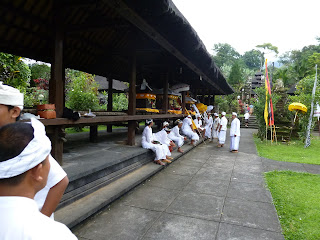One of the rituals we watched is the Kecak dance, which is a dramatization of part of the epic Ramayana. The 2-hour dance describes how Prince Rama's wife Siti is kidnapped by the evil goblin king, who spirits the aforementioned Siti away to his island while Prince Rama is off hunting. In the very abbreviated version we witnessed Prince Rama's friend Hanuman, the white monkey god, rescue Siti with the help of his monkey army. The ceremony was performed at night against the backdrop of one of the local temples, with a ceremonial fire burning in the middle of a circle of local men. The men sang an intricate chant meant to symbolize a gamelan orchestra. The percussive rhythm of the chant is actually pretty cool, and after a couple of beers (sold at the temple) I got pretty into it. This particular troupe does this ritual a couple of times a week solely for tourists, whom they charge about $8 a head for the privilege of viewing this authentic bit of Balinese culture.
Next, on a trip to Batukau temple in Central Bali we happened on what was apparently the entire population of a remote village which had made the trip to this very sacred site as part of a ritual that takes place once every thirty years. The participants told me that they made several stops along the way on this pilgrimage, and the ceremony at Batukau was the last step in the elaborate observance. Since every village in Bali has to do this particular ceremony once every thirty years, I would imagine that you would have a pretty good chance to see the same thing. It was interesting to see all the people decked out in special attire, but what was most interesting to me was how they arrived....standing in the back of cargo trucks. They told me that they all parked their cars about ten miles away and board the trucks to cut down on traffic. I've seen this type of "carpool" in many places in Indonesia (often times you see dozens of people packed shoulder to shoulder in the back of a dump truck), but I'm always taken aback by it.
We also had the chance to watch part of a cremation ceremony, called Pelebon. This is one of the most elaborate rituals in Bali and takes a lot of preparation. According to one person I talked to, because of the expense and effort involved, most villages save up dead people for about five years and then they do a collective ceremony for all of them together. This makes sense when you look at the pictures; these elaborate floats were built for one ceremony, and it can't be reused because it all gets burned up in the ceremony. The ritual is for renewal and purification so that the soul of the departed can come back and inhabit the body of a new family member, for as we learned in the previous post the Balinese view of the cosmos is cyclical in nature. I heard several accounts of how the whole thing works, but evidently the big bull you see in the photo is the vehicle to convey the spirit of the deceased to the next world. The guys carrying the bull float spin it around and tilt it back and forth to confuse the dead person's spirit so it doesn't come back to the village and cause trouble. The big tower represents heaven and earth. In preparation for this particular ceremony they actually took down the power lines, which cut the electricity to a significant part of town, so they could carry the big float to the graveyard without having to worry about getting electrocuted. Below you can see a video of part of the ceremony.





I could feel the amazing ethnic atmosphere in Bali as I read this article. What I found most interesting was the mixture of traditional rituals and the modern life. Offerings in automobiles, Kecak dance for tourism, packed pilgrims on the back of a truck… there are obvious modernization here and there, yet variety of holy rituals have remained intact, which is amazing. I, as a Japanese person, can find many similarities regarding these traditions and rituals, however, I feel a little sad because lots of traditions and rituals have been forgotten and overlooked overtime as the pace of life gets faster and faster. I think it is really pretty to spend some time to appreciate ancestors and lives by offering Canang Sari. I hope this humbleness in the hearts of people in Bali will be passed down to the next generation.
ReplyDeleteAs I understand, the majority of the people in Indonesia are muslims. According to Wikipedia 87% of the total population are muslims. Since Indonesia have a big population, many people are non Islamic believers. What's your opinion about how the different religious groups get along in the society? For example, take what you wrote about the Odalan festival which I understand is a Hindu festival. Do people from other religious backgrounds participate in these kind of festivals?
ReplyDeleteI’ve been to Bali before and have seen these “Canang Sari” alter, littering around Bali, especially around the Monkey Sanctuary with several hundred on the ground. It’s a great tradition for the culture to ward off bad sprites and bring in good luck.
ReplyDeleteTraveling around Bali is probably scary and a nightmare, not like in the United States. I have seen drivers driving unorganized, weave each other, and crowd into automobiles and mopeds, like a van full of circus clowns.